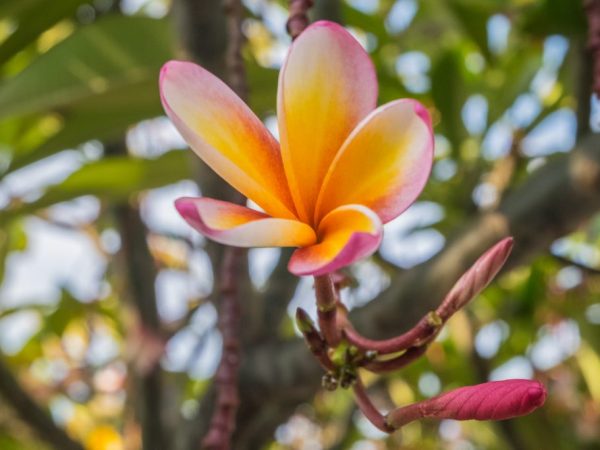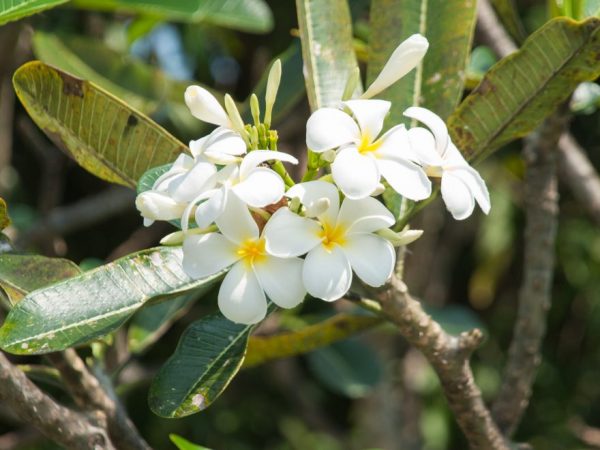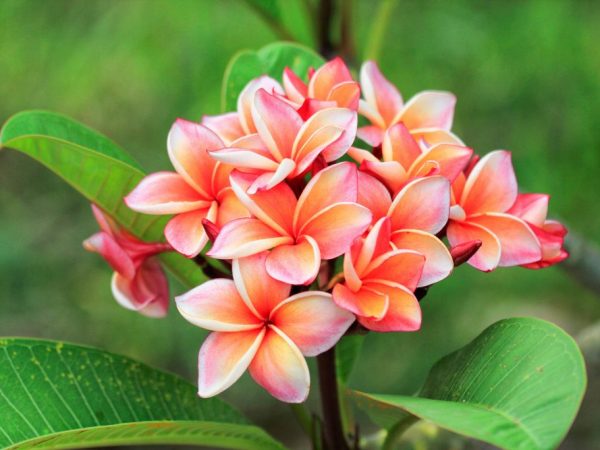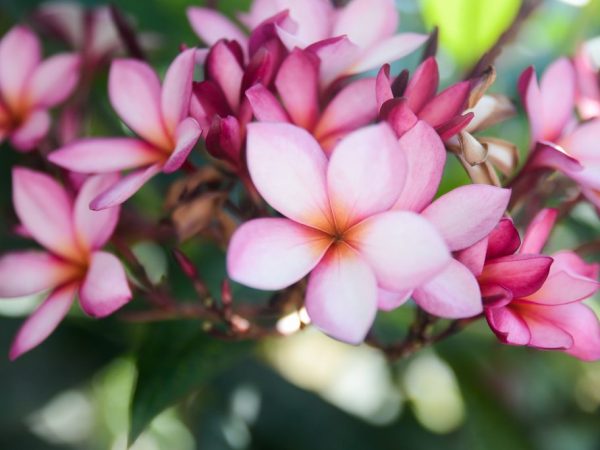Plumeria is a beautiful flower with a wonderful scent
Plumeria is a tropical plant native to Thailand, South America, Laos and Mexico. In many countries it is a national symbol; Russian flower growers appreciate it for its decorative effect and amazingly beautiful fragrant flowers. Their scent is unique and changes with the time of day and the environment.
- External description
- Varieties
- Purchase and adaptation
- Planting and transplanting
- The necessary conditions
- Soil selection
- Humidity
- Temperature
- Lighting
- Home care
- Watering
- Fertilizers and feeding
- Pruning, crown shaping
- Reproduction methods
- Seed propagation
- Cuttings
- Treatment of diseases and pests
- Meaning in tattoo
- Useful videos

Plumeria is a beautiful flower with a wonderful scent
External description
In nature, plumeria is a spreading bush or tree up to 15 m high, but in an apartment it rarely grows above 2 m.The leaves are long and dense, glossy, the flowers are large, up to 10 cm in diameter. The plant blooms for a long time, the whole warm season. The buds are bright, multi-colored, consisting of 5 petals.
The main attraction of plumeria is its aroma. He is strong and very peculiar, changing with the time of day, but extremely pleasant. The fruit is inedible, but it is easy to take seeds from it for planting. They germinate well if allowed to mature to the end.
Varieties
In nature, 7 varieties of plumeria are known, but only 3 of them are grown at home. They are most adapted to the middle lane, although they are considered rather capricious and difficult to grow.
- White (alba) is a plant native to the Caribbean Islands, partly deciduous. The leaves are green on the outside, silvery below. The flowers are white with swirling petals, close to each other. In the center of each flower, a yellow eye gapes - the main feature of the variety.
- Red (rubra) is a deciduous tree, in an apartment not exceeding 2 m. The bark is light and smooth, without growths, the leaves are narrow and long, with pointed ends. Flowers are collected in bunches, smell very tasty. The fruits are considered inedible, but in India exotic people are prepared from them. In Chinese medicine, the plant is classified as a medicinal plant.
- Dull (obtusa) - even in nature it reaches only 5 m in height. It is considered a dwarf variety. The tree is compact, branches from 30 to 40 cm, leaves with a velvet surface. The flowers are white-yellow, large, and have a persistent scent of jasmine.
Purchase and adaptation
It is very difficult to find plumeria in stores - it is rare. It's easier to order it in an online store, but the quality of delivery may not be up to par.
Usually they sell rooted cuttings or seedlings up to a year, they are transported in closed containers. After such transportation, the plumeria will require mandatory adaptation.
Do not immediately place the plant next to other indoor flowers. This is especially true for seedlings brought from afar. They can be infected with insects or viruses, which is dangerous for the rest of the green "inhabitants" of the apartment.
For 2-3 weeks, the plumeria should be carefully monitored, noticing the slightest changes in its condition.
You cannot immediately put the "newbie" in a bright light and begin to intensively water and feed.Let the tree at first just get used to the microclimate in the house. Especially if it was bought during the cold season. The plant has a dormant period when watering and fertilization should be minimized.
Planting and transplanting

We must transplant the flower into a new pot.
The first transplant is done after the purchase. During transportation, the plant is often placed in regular peat, which is not suitable for permanent maintenance. Therefore, after 1-2 weeks of adaptation in the house, it is transplanted into a new substrate. It is better to prepare it yourself, ready-made soils for kutrovy are not on sale.
The pot should not be too large - 2-3 cm wider than the diameter of the root ball. Otherwise, plumeria will grow, as in wildlife - up to 15 meters.
It is better to choose a heavier material of the container - clay, ceramics. This way, the branchy tree will not roll over and break. A large drainage from shards and expanded clay is laid out in the first layer on the bottom.
The second is leaf humus, compost, soil mixed with manure. Pour on top of the usual universal soil for flowers, mixed with coarse sand and vermiculite for better air and moisture permeability. The tree is placed with its roots on the ground and sprinkled with earth on all sides, slightly trampling it down.
Important! Watering the plant immediately after transplanting is not worth it - it will be possible to do this in a week with warm water.
The necessary conditions
Soil selection
It needs a nutritious soil, because it needs a lot of nutrients for flowering. There are no special soils for this type of plants, but it is easy to make it yourself.
The main thing is that the earth is loose and absorbs moisture well. To do this, it is necessary to add disintegrants to the store universal soil - vermiculite, perlite, polystyrene, small expanded clay, gravel.
For good growth and flowering of a tree, you will need to mix 1 part of coarse sand, humus, peat and compost with 2 parts of sod land.
Before planting, the soil must be disinfected in an oven or microwave.
Humidity
During the active period (from April to September), the plant needs high humidity. It can be achieved by spraying the crown of a tree, as well as by installing trays of water near the plant.
On the hottest days, when the moisture instantly evaporates, you can put the flowerpot in a container filled with expanded clay or moss filled with water.
During flowering, the plant is often sprayed, but it is impossible for the water to get on the buds themselves. They can dry out and curl up, and the fruit will not be tied. Water for irrigation should be prepared in advance in order to reduce its hardness and adjust it to room temperature.
Temperature
The plant loves warmth, even during the dormant period, the temperature around should not be lower than +17 ° C. True, the summer heat, when the thermometer table in the apartment rises to + 27-30 ° C, the tree also feels bad. At this time, the plumeria should be taken out into the garden or on the balcony, where it is cooler. But we must beware of drafts that are harmful to the tree.
In nature, plumeria grows at a constant temperature of + 20-25 ° C in winter and summer. In places of its growth, there are no large differences. Therefore, at home, the plant reacts painfully to both overheating and hypothermia.
It is necessary to try to minimize the difference between day and night temperatures, as well as differences at the beginning and at the end of the heating season.
Lighting
Plumeria is photophilous. She is not just not afraid of the direct sun, but needs it for at least 6 hours a day. In the apartment, the brightest place should be allocated for the plant. If necessary, the tree will have to be supplemented, otherwise it will not bloom.
It is better to put a flowerpot with a tree near the south window, in extreme cases, near the southeast one. The rest of the sides are not suitable for the plumeria. Even with additional illumination, the sun will be too little for her.
In the warm season, you can take the flowerpot out into the garden or on a bright veranda, but you need to monitor the temperature so that the plant does not freeze.
Home care

Do not flood the plant
This exotic “guest” needs careful care and conditions that are as close as possible to the natural, usual for a tropical tree.
Plants grown independently from seeds or cuttings are easier - they are already adapted to the environment.
Watering
If the drainage and the substrate are selected correctly, it will be difficult to flood the plant. The main thing is not to leave water in the pan. The tree does not like to stand in a "swamp", it will more easily endure a short-term drought than overflow.
Watering can be supplemented by spraying with warm water. This is useful - the pores in the leaves will not be clogged with dust, the plant will breathe easier.
Dense, tough leaves can even be wiped off periodically with a wet cloth. In cold weather, these procedures are not carried out, and watering is reduced to a minimum.
Fertilizers and feeding
As soon as the plumeria comes out of its dormant state, it needs to be fed. The first spring feeding is very important, because it gives the plant the strength for a lush and long flowering.
The most important element during this period is phosphorus, which stimulates the setting of buds.
Nitrogen affects the growth of green mass, but inhibits flowering. Overfeeding the tree is not worth it, it is permissible to give more at the end of summer.
During the growing season, food is carried out 2 times a month. It is better to use complex fertilizers - they have a more balanced composition.
The most suitable food for plumeria is:
- Good power;
- Bloom Plus;
- Florovit;
- Bona Forte;
- Marvel.
Pruning, crown shaping
Pruning a tree is necessary not only for an aesthetic appearance, but also for lush flowering. Buds appear only on young first-year branches, therefore, the more there are on the tree, the more flowers there will be.
They begin to form the crown in early spring, when the plant is just beginning to come out of hibernation. First of all, dried and weak branches are removed, then healthy, but too elongated to the sides. The crown needs to be shaped like a ball so that nothing sticks out. Pruned branches are used as cuttings.
Reproduction methods

Growing a flower yourself
There are several ways to propagate a plant yourself. It is not difficult at all if you follow the proven technology. It is better to start the procedure in the spring, then there will be more chances of success.
Seed propagation
The seeds ripen in a legume-like pod, only longer and narrower. For full readiness, they must ripen on the tree for a full 9 months. Before sowing, the seeds must be germinated by covering them with gauze and placing Epin Extra or Energen in a solution.
It is advisable to immediately plant the seeds in a separate glass - young seedlings do not tolerate transplanting well. Seed substrate - earth, coarse sand, perlite in equal proportions. The containers are covered with a whip and placed under the lamp. The temperature for germination must not be lower than +27 ° С.
The sprouts appear unevenly (another reason why it is better to plant them in separate containers) - from 10 to 25 days.
Gradually they are accustomed to room temperature and the film is finally removed. The sprouts are transplanted only the next year. Usually the plant blooms in the second year.
Cuttings
After pruning the tree, branches remain, 4 buds are left on each, dried and placed in Kornevin's solution for a day.
It is imperative to dry the stalk so that the milky juice ceases to stand out from it.
Cuttings are placed in a substrate - earth, coarse sand, perlite. Cover with foil on top, creating the effect of a greenhouse.
They are placed on a warm radiator or just in a warm place. The main thing is not to deepen them too much - 6-8 cm will be enough. Seedlings take root for about 3 months. Then the greenhouse is removed.
Treatment of diseases and pests
The plant rarely gets sick with good care. Problems appear only with improperly organized irrigation, lighting, temperature. In a cool and humid environment, the tree is attacked by a fungus, in the absence of light, it begins to rot.
The Putin mite settles on the plant when the leaves and trunk dry out.The rest of the insects do not attack the tree because of the poisonous sap.
| Prolema | Symptoms | Treatment | Prophylaxis |
| Rot | Blackened trunk, limp leaves | Removal of rotten branches, transplant | Correct watering regime |
| Fungal infection | Spots on leaves, shaggy bloom | Mechanical removal, treatment with fungicides Fundazol, Ridomil, Skor, Fitosporin | Bright lighting, regular inspection |
| Spider mite | Thin web between leaves | Rinse with water, spray with Antimite, Actellik, Aktara preparations | Regular inspection and spraying |
Meaning in tattoo
Fans of drawings on the body often stuff themselves with tattoos in the form of plumeria flowers. This always has a special meaning, symbolism, rooted in the depths of centuries. Since ancient times, this flower has been associated with eternal life, purity of thoughts, vitality, optimism.
A bouquet of flowers on a girl's thigh is a sign of special sexuality, a desire to please men.
A tattoo on the shoulder is a desire to find oneself, inner harmony. Yellow buds are the joy of being, success in everything. Flowers in the shape of a cross are a reminder of the transience of life, the memory of deceased relatives.
Flowers are often stuffed together with "live" exotic - tropical fish, butterflies, hummingbirds. This means that a person is open to the world, loves to learn new things and travel. It is also a sign that you need to live today and now, enjoying every minute.
Useful videos
An exotic tree from Hawaii can become a regular inhabitant of a city apartment if it is properly cared for. Simple requirements for watering, lighting, humidity, transplantation make plumeria a welcome "guest" in the home of any florist.

